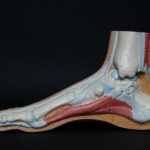Prepare to embark on a captivating journey through the hidden wonders of the human body as we delve into the realm of tendons. Brace yourself for a life-like cinematic experience, as our spotlight falls upon the unsung hero of human anatomy: the smallest tendon in the human body. In this awe-inspiring exploration, we will unravel the mysteries that lie within this minuscule yet mighty structure, showcasing its vital role in the symphony of our bodily functions. Get ready to witness the unveiling of this mini marvel and discover secrets that will forever transform your perception of our extraordinary human form.

Smallest Tendon In Human Body
Did you know that hidden within the depths of your inner ear lies a true marvel of nature? The human body’s smallest tendon, so delicate yet so crucial to our sense of hearing, is tucked away in this inconspicuous location. This tendon, known as the stapedius tendon, attaches to the smallest muscle in the body, the stapedius muscle. Together, they form a remarkable contractile unit that plays a vital role in the functioning of our auditory system.
When we think of tendons and their importance, we often envision the larger ones like the Achilles tendon connecting our calf muscle to the heel bone. However, it’s the smallest tendon that deserves a moment in the spotlight. Picture a tiny, intricately woven structure that measures only a few millimeters in length, but possesses immense significance.
But what exactly is the purpose of this diminutive tendon and muscle duo? Well, they work together to stabilize and control the movement of the smallest bone in our body – the stapes or stirrup bone of the middle ear. This bone forms a crucial part of the complex mechanism responsible for transmitting sound waves to our auditory nerves.
The stapedius muscle, being the smallest skeletal muscle in our body, measures approximately 6 millimeters in length. Alongside the stapedius tendon, it acts as a natural dampener, preventing excessive movement of the stapes bone and helping to regulate the transmission of sound vibrations in the inner ear. This delicate control mechanism allows us to hear sounds clearly and accurately, contributing to our overall auditory experience.
While the stapedius tendon may be small in stature, it possesses immense strength and resilience. Tendons are made up of dense regular connective tissue and contain tendon cells, or tenocytes, that synthesize the tendon’s extracellular matrix. This matrix, rich in collagen fibers, gives tendons their remarkable durability and elasticity.
However, despite their strength, tendons can still be susceptible to injury. A strained or overexerted tendon might take a considerable amount of time to heal. That’s why it’s crucial to take care of all our tendons, regardless of their size.
The hierarchal organization of tendons, ranging from microscopic to macroscopic structures, showcases the intricacies of our body’s design. Collagen fibrils form collagen fibers, which further join to create primary fiber bundles. These primary bundles then combine to form secondary and tertiary bundles, forming the larger tendons we are more familiar with.
When it comes to the smallest tendon in the human body, the stapedius tendon reigns supreme. Its inconspicuous location within the inner ear reminds us of the hidden wonders that lie within our bodies. So, let’s appreciate and cherish the marvelous harmony of our muscular-skeletal system, from the smallest tendon to the largest, for they all contribute to our remarkable existence.
“Discover the whispers of nature that resonate within the smallest tendon in your body.”
Tendons are fascinating and often overlooked parts of our bodies. They play a crucial role in connecting muscles to bones, allowing for movement and flexibility. If you’re curious to learn more about the incredible facts about tendons, click here to explore them further: facts about tendons. Prepare to be amazed by the remarkable strength and resilience of these connective tissues. Discover the secrets behind their ability to withstand immense forces and support our daily activities. Delve into the world of tendons and uncover the wonders they hold!
The human body is a remarkable and intricately designed machine. From the largest organs to the tiniest structures, each component plays a vital role in our overall health and well-being. One such incredibly small yet important part of our body is the smallest tendon. Yes, you heard it right! The smallest tendon in the human body is a fascinating feature that deserves our attention. Smallest tendon
While it may be easy to overlook something so small, this minuscule tendon serves a significant purpose. Connecting muscles to bones, it ensures smooth movements and provides stability to our joints. Without this tiny yet mighty tendon, simple actions like walking or lifting objects would not be possible. Its strength and resilience are truly remarkable.
Now, you might be wondering, what exactly is the smallest tendon in the human body? To find out more about this intriguing component, dive deeper into the world of human anatomy and discover the wonders it holds. Explore the human body and unravel the secrets that lie within. From the invisible microcosms to the awe-inspiring macrocosms, the human body never ceases to amaze.
So, whether you’re a fitness enthusiast, a curious learner, or simply fascinated by the wonders of the human body, don’t miss the chance to explore the intricacies of the smallest tendon. Click here to embark on a journey of discovery and gain a newfound appreciation for the remarkable design of our bodies.
Keep exploring, keep learning, and keep marveling at the wonders that lie within us!
The Smallest Muscle in the Human Body: Exploring the Stapedius Muscle
[youtube v=”m5BTfH9vn5U”]
What is the Smallest Muscle in the Body?
The stapedius muscle holds the distinction of being the smallest muscle in the human body. This skeletal muscle is approximately one to two millimeters in length and is connected to the bone. Located in the inner ear, it plays a crucial role in our auditory system.
The Role of the Stapedius Muscle
Working in conjunction with the stapedius tendon, the stapedius muscle is responsible for stabilizing and controlling the movement of the stapes bone in the middle ear. The stapes bone acts as a vital component in transmitting sound waves to our auditory nerves, making the role of the stapedius muscle essential in our ability to hear.
Dampening Sound Vibrations
One of the primary functions of the stapedius muscle is to act as a dampener for sound vibrations in the inner ear. By regulating the transmission of sound waves, it helps prevent excessively loud noises from damaging our delicate auditory system. This fascinating aspect showcases the hidden wonders of the body’s muscular-skeletal system.
The Structure of Tendons
To better understand the stapedius tendon, let’s delve into the structure of tendons in general. Tendons are composed of dense regular connective tissue and contain collagen fibers. These fibers provide tendons with strength and resilience. Ranging from microscopic collagen fibrils to larger primary, secondary, and tertiary bundles, the organizational structure of tendons is both impressive and intricate.
The Importance of Care and Rehabilitation
While tendons are remarkably resilient, they can still be susceptible to injury. Proper care is crucial to ensure their proper healing. Rehabilitation exercises, physical therapy, and rest are often recommended to aid in the recovery process. Taking care of our tendons is essential to maintaining our overall mobility and well-being.
In conclusion, the stapedius muscle and tendon combination represents a remarkable feat of the human body’s intricate design. As the smallest muscle and tendon, they work together to stabilize and control the movement of the stapes bone, ensuring the smooth transmission of sound waves for our auditory system to interpret. Understanding and appreciating these hidden wonders highlights the complexity and awe-inspiring nature of our muscular-skeletal system.
FAQ
What is the smallest tendon in the human body?
The smallest tendon in the human body is located in the inner ear and attaches to the smallest muscle in the body, known as the stapedius muscle.
What is the role of tendons in bodily functions?
Tendons play a crucial role in bodily functions by working together with muscles as a contractile unit to move joints and facilitate movement.
Which is the largest tendon in the human body?
The largest tendon in the human body is the Achilles tendon, which connects the calf muscle to the heel bone.
How resistant are tendons to tearing?
Tendons are highly resistant to tearing. However, they can be easily injured when strained, and the healing process for tendon injuries can be lengthy.
How are tendons structured hierarchically?
Tendons have a hierarchical structure, starting from collagen fibrils that form collagen fibers, which then form primary fiber bundles, secondary fiber bundles, and finally tertiary bundles. This hierarchical organization gives tendons their strength and flexibility.
“`json
“`
- China II Review: Delicious Food & Speedy Service - April 17, 2025
- Understand Virginia’s Flag: History & Debate - April 17, 2025
- Explore Long Island’s Map: Unique Regions & Insights - April 17, 2025
















